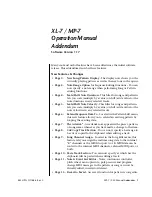
Multec 3.5 Fuel Injector Application Manual
System Interface
Delphi Energy and Chassis Systems
Revision:
11/05-1
4-5
4.2.3 Vibration
Levels
4.2.3.1 Vibration Durability Requirements
Component vibration levels should be measured as soon as proper
hardware is available to ensure that engine vibration is within acceptable
limits.
Before a validation statement can be completed, the vibration levels need
to be analyzed for each application.
If resistance to dynamometer engine vibration levels (usually higher than
vehicle levels) is required, this should be communicated to the Delphi
Design Engineer.
4.2.3.2 Vibration
Measurement Techniques
The following vibration measurement procedure is recommended:
1. Use accelerometers to take vibration measurements in three orthogonal
directions with respect to the injector — the axis through the mounting
is longitudinal, perpendicular to the mounting axis is lateral, and
through the injector is vertical. Sketch or photograph the
accelerometers and locations, identifying the axis orientations with the
data. To eliminate confusion when comparing data, it is imperative
that a sketch of the part with the axis be included with the data sets.
2. Place the accelerometer on an appropriate mount. (Usually the fuel
rail mounting bolt.)
3. If possible, attach a second accelerometer on the injector body to
measure the response of the unit.
4. Once accelerometers with the proper charge amplification or signal
conditioning are set up, run the engine and acquire data. Tape record
measurements for later laboratory analysis.
When tape recording data, set the recorder to a tape speed such that the
minimum usable frequency range is 20-2500 Hz. Because engine
vibration can be classified as stationary random, data must be taken
and averaged. Twenty to 30 seconds of data are needed to get a true
picture of the environment. Data should be at steady-state operating
conditions, with the engine loaded as it typically would be during
operation. A tachometer signal should be monitored and recorded to
correlate engine rpm to the data.
Steady state rpm data is necessary at idle, 1000, 1500, 2000… through
redline. A slow speed sweep (three to five minutes in duration) from
idle to redline should be made as well.
















































